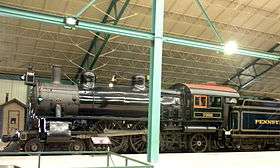Pennsylvania Railroad class E2
| Pennsylvania Railroad E7s |
|---|
|

|
| Type and origin |
|---|
| Power type |
Steam |
|---|
| Builder |
Altoona Works, Alco |
|---|
| Build date |
1916 |
|---|
| Total produced |
90 |
|---|
|
| Specifications |
|---|
Configuration:
|
|
|---|
| • Whyte |
4-4-2 |
|---|
| Gauge |
4 ft 8 1⁄2 in (1,435 mm) |
|---|
| Leading dia. |
36 in (910 mm) |
|---|
| Driver dia. |
80 in (2,000 mm) |
|---|
| Trailing dia. |
50 in (1,300 mm) |
|---|
| Length |
68 ft 6 in (20.88 m) (including 55P58 tender)[1] |
|---|
| Adhesive weight |
118,400 lb (53,705.3 kg)[1] |
|---|
| Loco weight |
171,100 lb (77,609.7 kg)[1] |
|---|
| Tender weight |
89,050 lb (40,392.4 kg) |
|---|
| Fuel type |
Coal |
|---|
| Fuel capacity |
27,600 lb (12,519.1 kg)[1] |
|---|
| Water cap |
5,800 US gallons (22,000 l; 4,800 imp gal)[1] |
|---|
Firebox:
• Firegrate area |
55.5 sq ft (5.2 m2) |
|---|
| Boiler pressure |
205 psi (1,410 kPa) |
|---|
| Cylinders |
2 |
|---|
| Cylinder size |
22.5 in × 26 in (572 mm × 660 mm) |
|---|
|
|
|
|
|
The Pennsylvania Railroad's class E2, E3, E7 steam locomotives were of the 4-4-2 "Atlantic" passenger type, frequently called “light Atlantics” after the introduction of the heavier E6 Atlantics. All were similar in size and boiler capacity but differed in firebox type, valves and valve gear, and cylinder diameter. Classes E2 and E3 were built simultaneously. Starting in 1916 a rebuilding program converted ninety class E2a,b,c to class E7s by replacing slide valves with piston valves and increasing cylinder diameter from 20.5 to 22.5 inches (520 to 570 mm). Fourteen class E2 were similarly converted to class E7sa. Ninety class E2a,d, E3a,d were converted to class E3sd. These improvements allowed many of the engines to remain in active service into the 1930s.
The sub-classes differed as follows:[2]
| Class |
Firebox |
Cylinder size |
Valves |
Valve gear |
Number built |
Years built |
| E2 |
Radial-stay |
20 ½” x 26” |
Slide |
Stephenson |
88 |
1901-02 |
| E2a |
Belpaire |
20 ½” x 26” |
Slide |
Stephenson |
93 |
1902-05 |
| E2b |
Belpaire |
20 ½” x 26” |
Piston |
Stephenson |
70 |
1903-04 |
| E2c |
Belpaire |
20 ½” x 26” |
Slide |
Stephenson |
22 |
1903 |
| E2d |
Belpaire |
20 ½” x 26” |
Piston |
Walschaerts |
32 |
1906-08 |
| E3 |
Radial-stay |
22” x 26” |
Slide |
Stephenson |
8 |
1901-02 |
| E3a |
Belpaire |
22” x 26” |
Slide |
Stephenson |
114 |
1903-05 |
| E3d |
Belpaire |
22” x 26” |
Piston |
Walschaerts |
56 |
1906-10 |
| E7s |
Belpaire |
22 ½” x 26” |
Piston |
Stephenson |
90 conv. fr. E2a,b,c |
1916-20 |
| E7sa |
Radial-stay |
22 ½” x 26” |
Piston |
Stephenson |
14 conv. fr. E2 |
1916-20 |
In the first decade of the twentieth century classes E2 and E3 handled all of the fast passenger trains of the Pennsylvania Railroad. As train weights increased due to the switch to steel passenger cars and more cars per train, the “light” Atlantics were usually double-headed. Eventually, as Pacific class K2 and K3 became available, they were relegated to secondary service
Engine #7002
This engine was built in 1902 as a class E2 for the Pittsburgh, Fort Wayne and Chicago Railway as engine #2 (renumbered to 7002). On the first westward run of the Pennsylvania Special (renamed the Broadway Limited in 1912) in June 1905 the conductor clocked the train over three miles just west of Lima, Ohio in 85 seconds, at a record speed of 127.1 MPH. (Many doubt the claim; the train averaged about 68 mph from Crestline to Fort Wayne.) The 7002 was rebuilt to class E7sa in August 1916 and scrapped in 1935. When the PRR was looking for an E7 class locomotive for preservation, they refurbished No. 8063 (an E7s from PCC&StL) and substituted 7002’s engine number and builder’s plate. The engine was donated to Railroad Museum of Pennsylvania in 1979 and put into operating order by Strasburg Rail Road where it ran for a number of years, sometimes double-heading with PRR D16 #1223. It last ran on December 20, 1989.
References
- 1 2 3 4 5 Pennsylvania Railroad. "PRR E2a,E3a Steam Loco". PRR.Railfan.net. Retrieved January 2, 2008.
- ↑ Staufer, Alvin F; Edson, D. William; Harley, E. Thomas (1993). Pennsy Power III. ISBN 0-944513-10-7.